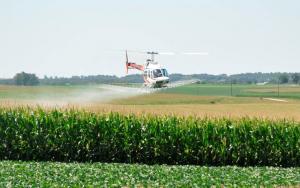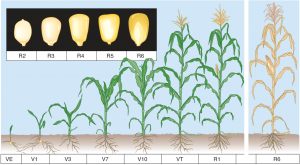Over the late summer and early fall months, Iowa corn farmer Greg Alber maintained a positive outlook for his 2015 crop. However, minor set backs included fungal disease and lack of moisture in his fields.
All of Alber’s corn fields were sprayed at least once with fungicide to fight off Northern Corn Leaf Blight (NCLB), a fungus caused by Exserohilum turcicum. Some fields were sprayed twice. According to Iowa State University Extension and Outreach, NCLB can result in yield losses of 30 percent or more but can be effectively controlled with proper fungicide use.
Alber first applied fungicides with an elevated sprayer driven through the corn fields. After the row canopies closed and fields became impassible by machines, he used aerial application to distribute the chemicals.
When using aerial application methods, small airplanes or helicopters fly over fields to administer the fungicides. This practice is highly regulated by federal and state laws to ensure the safety of the farmer and those in his community. [See “Farmer Certification� story in this issue.]
By mid-September, Alber’s corn was in the kernel dent stage, also referred to as R5. Some fields have begun black layering, which indicates physiological maturity of the crop. A black layer forms when the hard starch layer reaches the kernel base. The layer serves to cut off water and nutrient transfer into the kernel.
Earlier in the growing season, Alber believed this year’s crop was on track to be one of his best based on varieties planted and favorable conditions in his region.
Alber is still hoping for 200 bushels/acre (12.6 tons/hectacre) corn, which is above the national average yield. “But we will just have to wait and see,� Alber said. “We are about three weeks out from harvest, so we will know a lot more by the middle of October.�
In USDA’s World Agricultural Supply and Demand Estimates (WASDE) report released on Sept. 11, U.S. corn production was estimated to be 13.6 billion bushels (345 million tons) with the national average yield at 167.5 bushels per acre (10.5 tons/hectare).
However, Alber said he fears low test weights, stalk quality issues and ear droppage because of the dry weather he experienced during July and August. He said that once the corn is dry enough, the fields must be harvested quickly.
A USDA National Agricultural Statistics Service (NASS) report showed 68 percent of the corn crop in the United States was in good to excellent condition on Sept. 21, down from 74 percent in 2014.
Alber said this report gave the market a little push, but with current low prices and increasing input costs, corn farmers will be lucky to break even in 2015.



